A villa in the Turin area, a late 19th-century photograph discovered by chance, the determination of two young antiquarians. And, above all, the rediscovery of a masterpiece of 18th-century Genoese sculpture that, after more than a century, has returned to Genoa. These are the elements behind the discovery of thealtar of the Immaculate Conception, a very fine work by Francesco Maria Schiaffino (Genoa, 1689 - 1765), unveiled to the public yesterday, May 18, 2023, at the headquarters of Goldfinch Fine Arts, the gallery founded by Luigi Pesce and Clemente Zerbone. Who, in front of this splendid work in statuary marble from Carrara , admit to having had a bit of luck: even luck, after all, is sometimes needed if one is in the antiquarian business, which can be “particularly adventurous,” as they themselves emphasize. The astonishment of those who admire this work for the first time can perhaps give an idea of what they felt when they found themselves in front of this altar: having perceived thevery high quality of the work and found theexceptional state of preservation, they immediately commissioned the necessary studies to frame the sculpture and discover where it came from. And it turned out that this Immaculate Conception has an illustrious provenance: a 19th-century photograph, found almost by chance in a recent publication, in fact shows that in ancient times the work was located in the chapel of Palazzo Lomellini - Doria Lamba - Ponzone, in the heart of the neighborhood where the Lomellini family lived, near the basilica of Vastato. A building whose first news, as reconstructed by scholar Roberto Santamaria (he is credited with tracing the origin of the altar), date back to the late 16th century, when the property is mentioned in the will of Bannetta Garibaldi, widow of Francesco Lomellini.
TheImmaculate Conception dates back to the time of the expansion of the palace, commissioned to the very young Swiss architect Giovanni Angelo Gregorio, in his first Genoese work, by Bartolomeo Lomellini: the chapel that housed the rediscovered altar was built by 1753, while the bishop’s authorization to officiate celebrations inside dates back to 1756. Consequently, it is within this three-year period that the execution of the altar with the statue surmounting it should be placed. The identification, as mentioned, was possible on the basis of a photograph from the late 19th century, published in 2022 in a book on the Doria Lamba family, written by Lodovico Doria Lamba and Andrea Lercari and published by Sagep: there the chapel can be seen as it was before it was converted into a “dressing room,” which is mentioned in a description of the building from before 1898, the year the palace became the property of the Ponzone family.

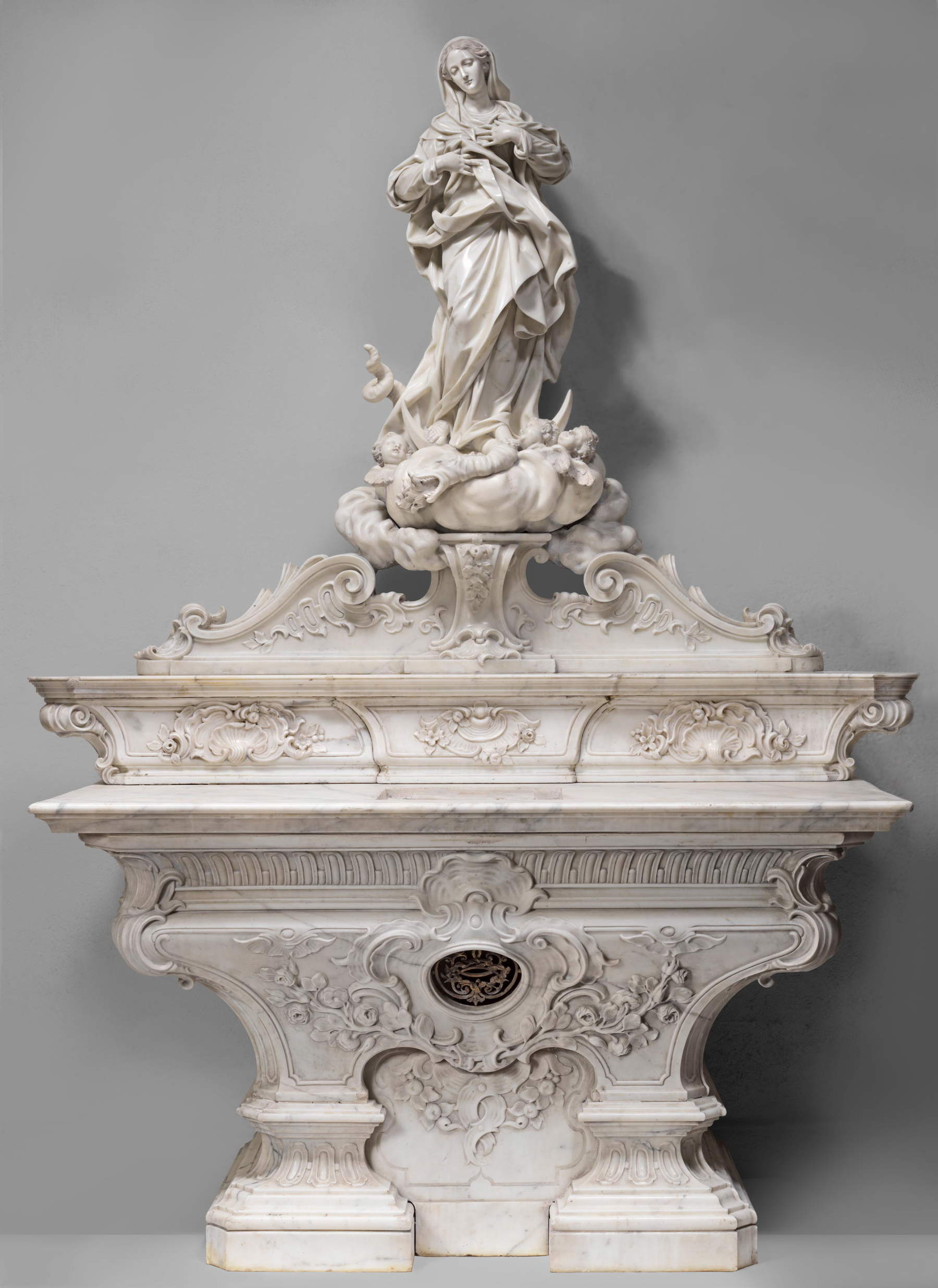
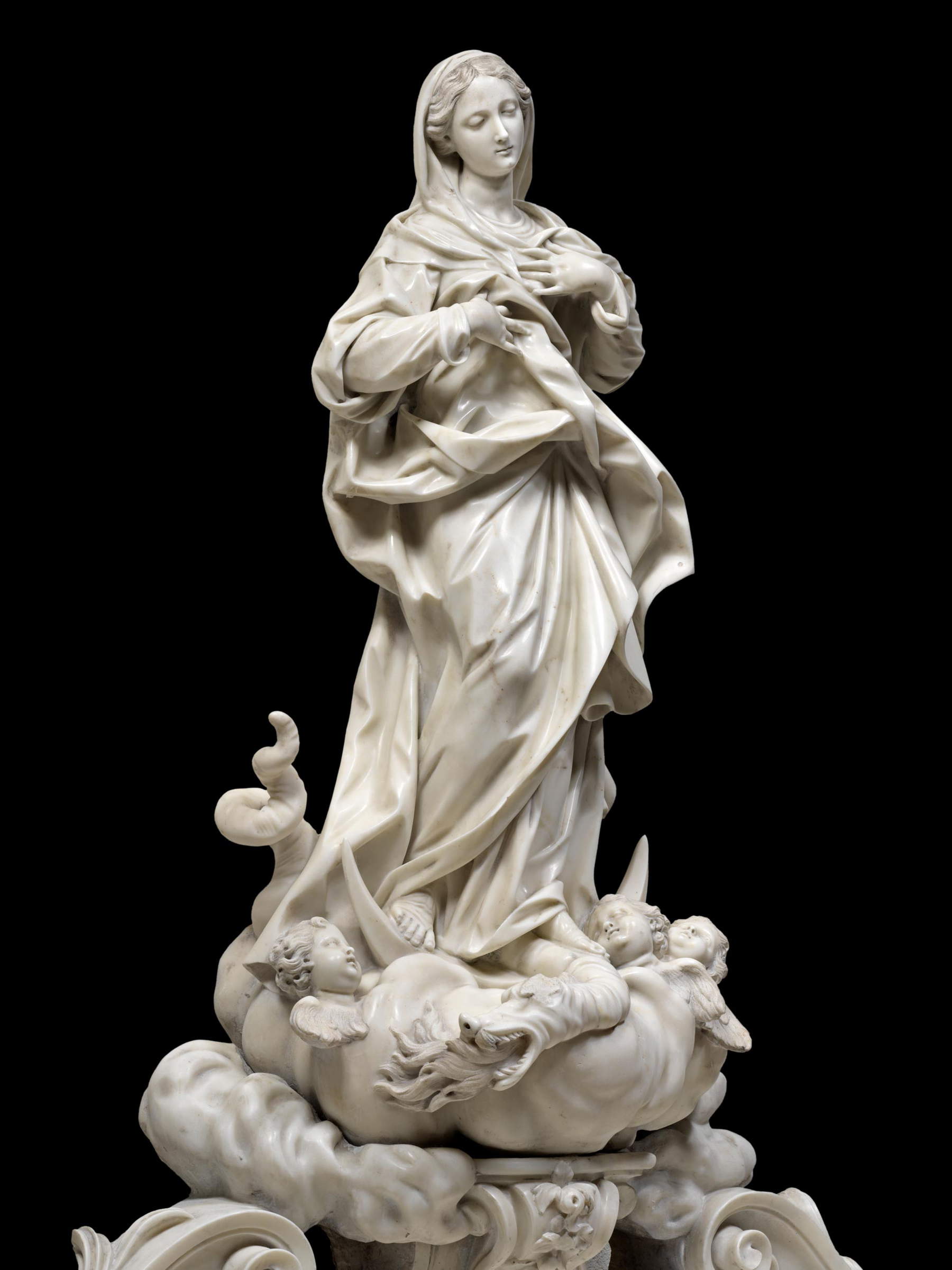
On the other hand, we do not know, exactly, when the altar left the palace and what paths it took before reaching the last ownersî. But as soon as one sees the statue of the Immaculate Conception, one realizes, even at first glance, that one is in front of a very fine work: the young art historian Gabriele Langosco, commissioned to study the work with a view to its publication, defines it as “a work capable of embodying the essence of Genoese sculpture of the eighteenth century,” of which it has all the main features. The movement, the draperies that fall fluidly and almost fluttering with the folds that seem to be crumpled and contrast with the delicacy of the epidermis (note the full hands with fingers yet tapered, with the virtuosity of thering finger of the right hand hidden under a fold of the robe), and then again the grace with which the Virgin’s face is infused, the elegance of the gestures and pose, the sinuous line, the sense of lightness that the figure exudes, the virtuoso and very studied alternation of empty and full spaces that create intense effects of light and shadow: these are the elements that best identify the stylistic signature of Francesco Maria Schiaffino. In keeping with the typical iconography of the Immaculate Conception, the Virgin rests her feet on the half-moon, a clear reference to the well-known Johannine image (in particular chapter 12 of Revelation: “a woman clothed with the sun, with the moon under her feet and on her head a crown of twelve stars”), as well as a symbol of Mary’s purity and chastity, and at the same time crushing the devil traditionally depicted in the form of a serpent, an allusion to her victory over sin: the apparition takes place on a cloud from which sprout heads of cherubim, to express the Virgin’s closeness to God.
We have no documents to testify the commission to Schiaffino, but the attribution to the Genoese sculptor is evident, and is supported by the stylistic elements, as Langosco explains: “The closeness of the marble to the best works of the master’s late activity, the very unique ’making of cloths,’ and the presence of elements that are part of the master’s figurative repertoire inform us that the sculpture came out of Schiaffino’s workshop.” And in the context of Francesco Maria Schiaffino’s frenetic workshop , from which came out works of not always sustained quality since the sculptor could count on a substantial number of collaborators who often intervened extensively on orders, theImmaculate Conception rediscovered by Goldfinch can be considered a product due mostly to the master’s hand: “The sustained qualitative discourse-which is found only in works of full autography-and the clarification of the chronological coordinates of realization,” Langosco continues, “lead to the exclusion of an extensive involvement of his pupils in the workmanship of the Immaculate Conception. It seems possible to recognize here one of the very rare marbles widely ’touched’ by the master.”
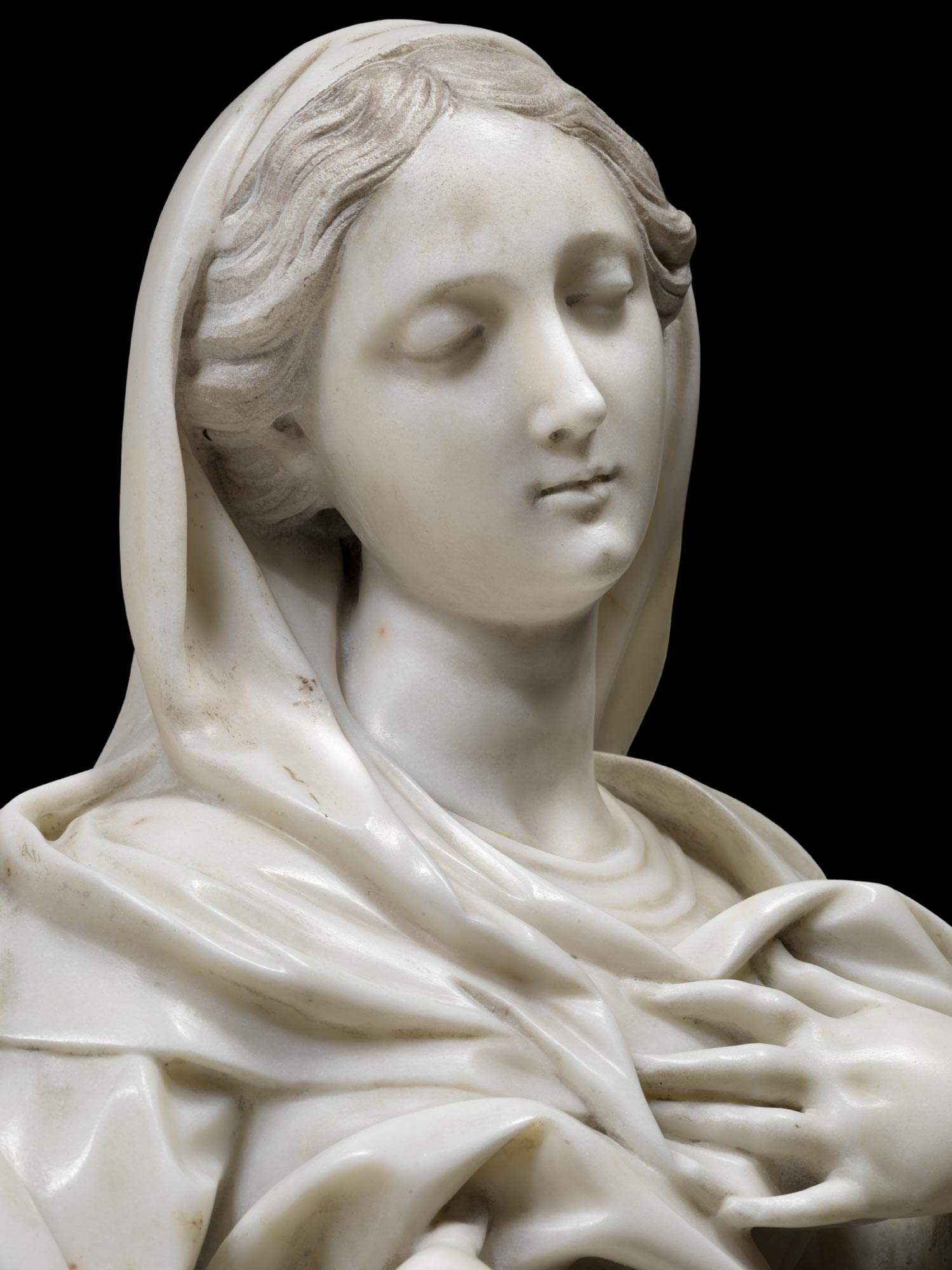
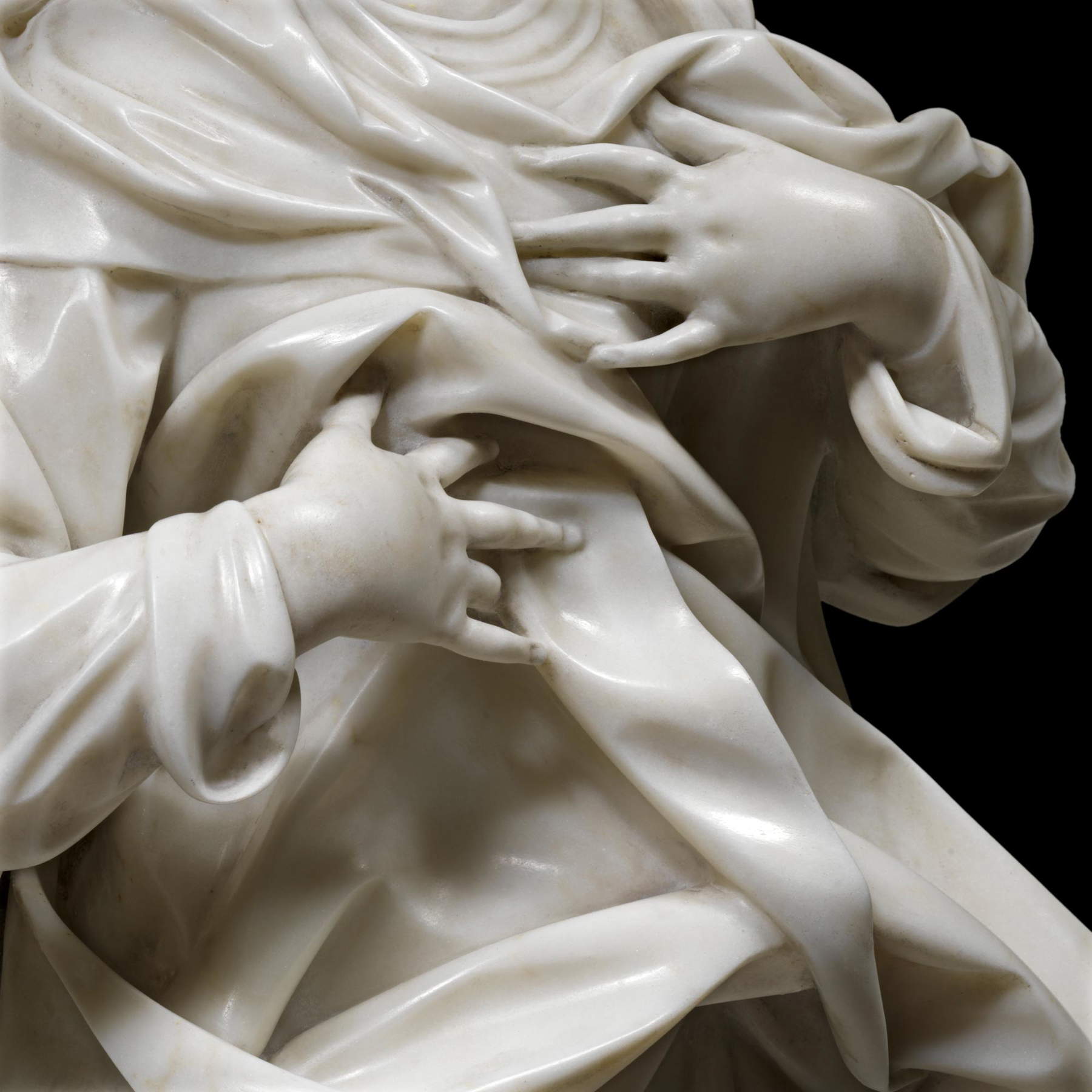
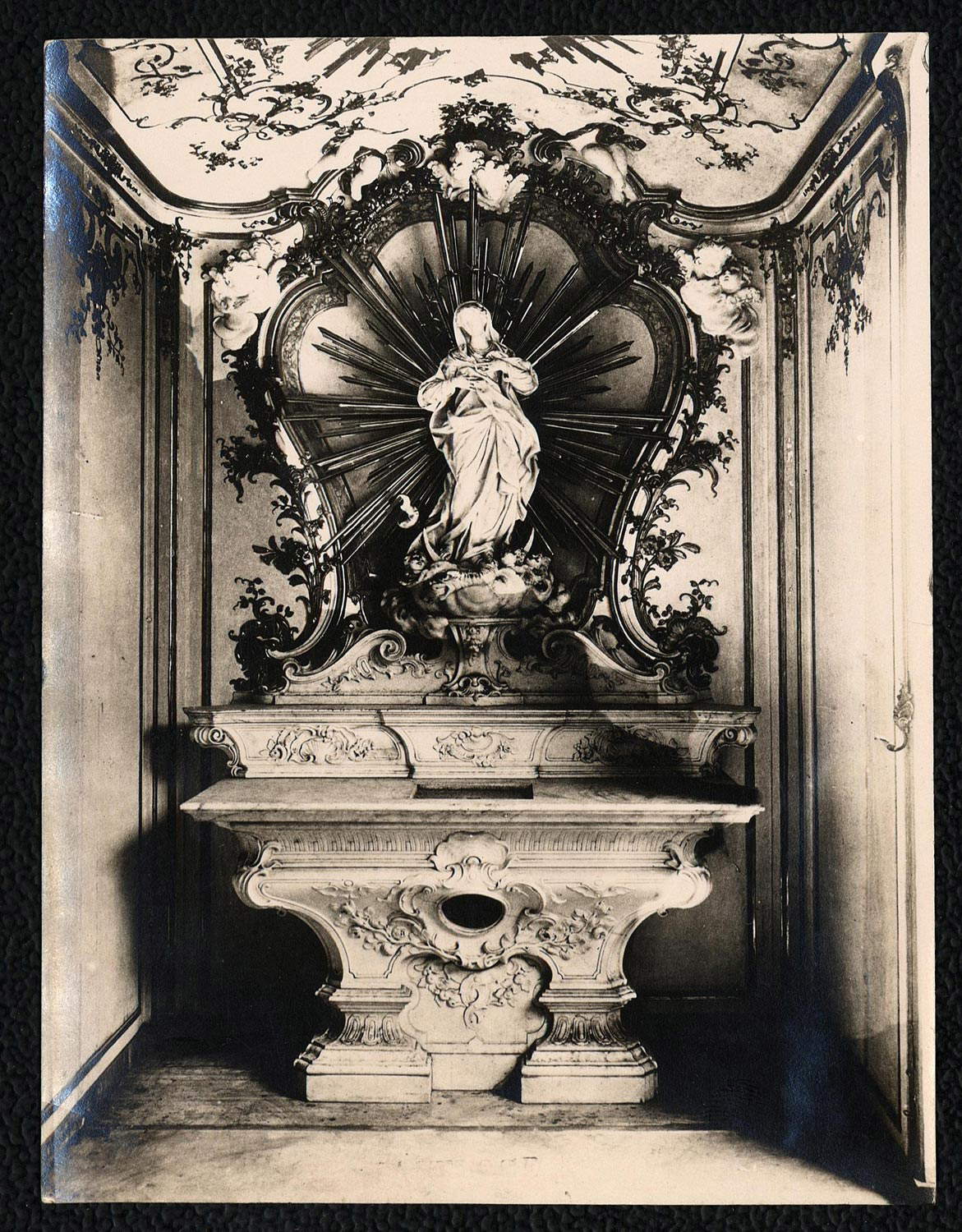
The comparisons that have made it possible to assign theImmaculate Conception to Schiaffino without particular doubt are with a group of works from the 1850s and 1860s. The probably more accurate one is with theAdoration of the Shepherds from the Scuole Pie in Genoa, a work from 1762, thus slightly more recent than theImmaculate Conception: the face of the Virgin in the two sculptures is almost superimposable, with its oval but not too elongated shape, long, straight nose, large eyes with a protruding upper eyelid, hair with a parting in the center, and a small, unfleshy mouth with barely parted lips. One can then call into question the St. Anne and Mary Child of the church of St. Anne in Genoa, especially the identical way the draperies are conducted (particularly along the sleeves and around the head: “the choice to end the robes with a triangle of fabric wedged between the feet,” Langosco explains, “is perhaps due to the practice-experienced on the model-of tightening a flap of fabric in order to exert a slight downward pressure, and then arranging it to touch the base”), and also for the pose of the Maria Bambina who brings her hands to her chest placing her arms parallel to her shoulders, as a sign of devotion (“tapering and flexing in the most anti-naturalistic late Baroque spirit,” wrote Giacomo Montanari, a scholar and expert on Genoese things of the time), exactly as happens in Goldfinch’s Immaculata. And concrete similarities can also be found in the cloud with cherubs. The St. Anne is a work from the early 1950s, and from the same period, though slightly later, is theAddolorata from the church of San Siro in Nervi, another important reference point for assigning theImmaculate Conception to Schiaffino, despite the fact that the latter is a work of higher quality than the San Siro. Preceding it by about twenty years, but useful for having a comparison on the same iconography, is theImmaculate Conception of the Church of the Redeemer in Genoa, resolved with a very different pose than the one executed for the Lomellini palace, which instead appears closer to the aforementioned Maria Bambina of the Church of St. Anne. To get an idea of the fineness of Schiaffino’s work, it could be compared to a similar work by another artist, executed in the same period (it was begun after 1741 but was perhaps finished much later), Giovanni Antonio Cybei’sImmaculate Conception , executed for the private oratory of Francesco Ubaldo Berrettari and now preserved in the chapel of the Ospedale Civico in Carrara: Cybei’s albeit elegant and fine sculpture appears less light and less exuberant than Schiaffino’s extraordinary sculpture, which was nonetheless in turn an inescapable point of reference for the sculptor from Carrara, some 20 years younger.
Themarble altar on which the Virgin is placed also deserves a mention: the work of Schiaffino’s workshop, it is small in size compared to the large contemporary altars that can be admired in the city’s churches, but it is certainly singular for its quality and for certain of its peculiarities, first and foremost the fact that the mensa on which the Immaculate Virgin rests is made entirely of Carrara marble. A rarity, since similar altars in private chapels were often made mostly of stucco or wood. Another peculiarity is the choice of the type of marble: statuary, the white marble par excellence, at a time when the dominant taste favored the choice of polychrome marbles. In this case, as noted by Roberto Santamaria (who, moreover, in his study of the altar of theImmaculate Conception, first attributed two other altars to Schiaffino: those in the churches of Santa Maria Maddalena in Genoa and San Giacomo di Rupinaro in Chiavari), the choice of white marble responded to the need for balance with the environment that housed the entire machine. More usual, however, is the structure of the altar, which imitates, in a small way, that of the great altars of the late Baroque Genoese churches, such as the one executed in 1670 by Pierre Puget for the church of San Siro, the earliest late Baroque altar that can be traced in the city: one moves away from the logic of the altar with its rigid and rigorous forms to a structure that, as in this case, rests on a base that expands horizontally with curvilinear motion, going to support a horizontal balustrade on which, in turn, is installed a sort of tympanum culminating in two graceful decorated volutes, in the center of which rises a pedestal that holds the statue of Schiaffino. A structure all mellowed by Marian decorative elements, such as roses and shells.
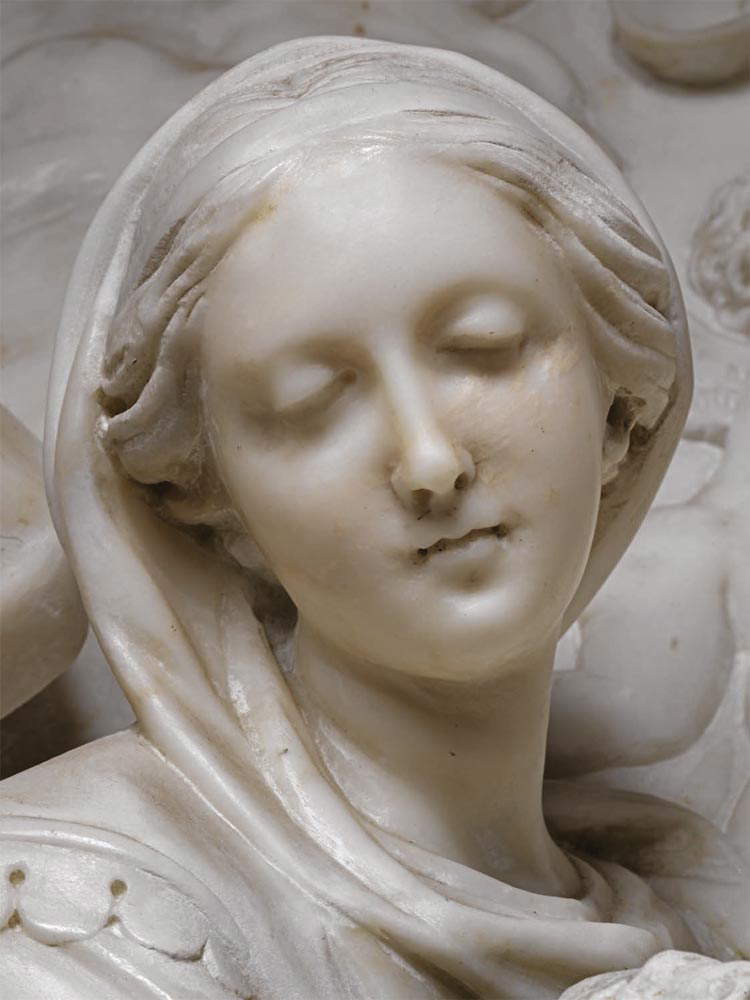
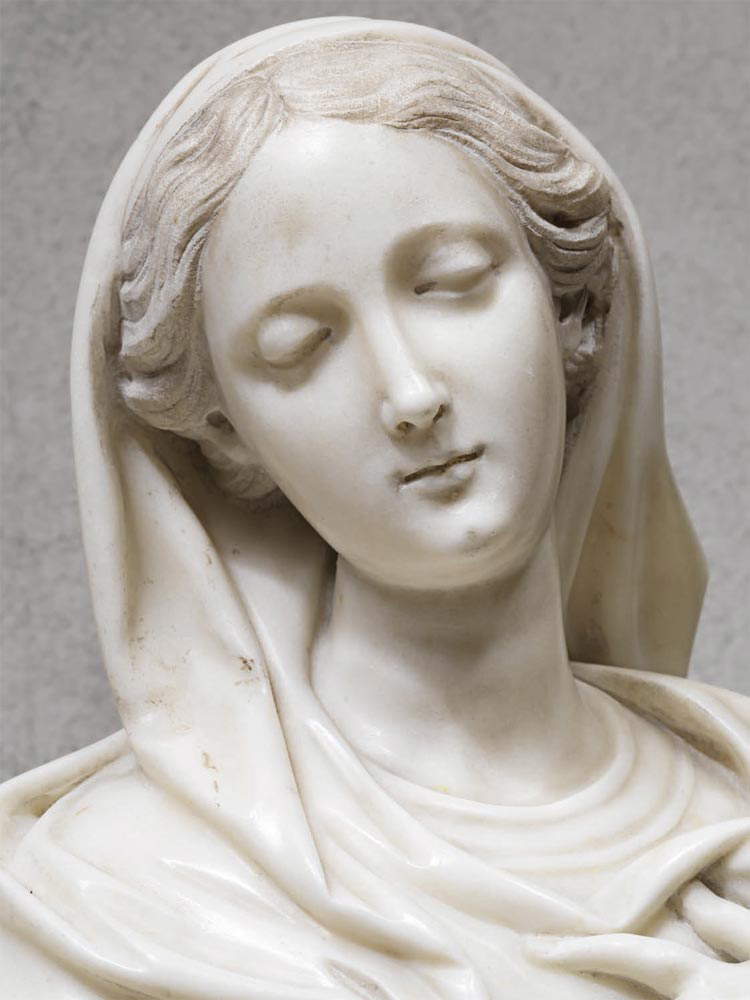
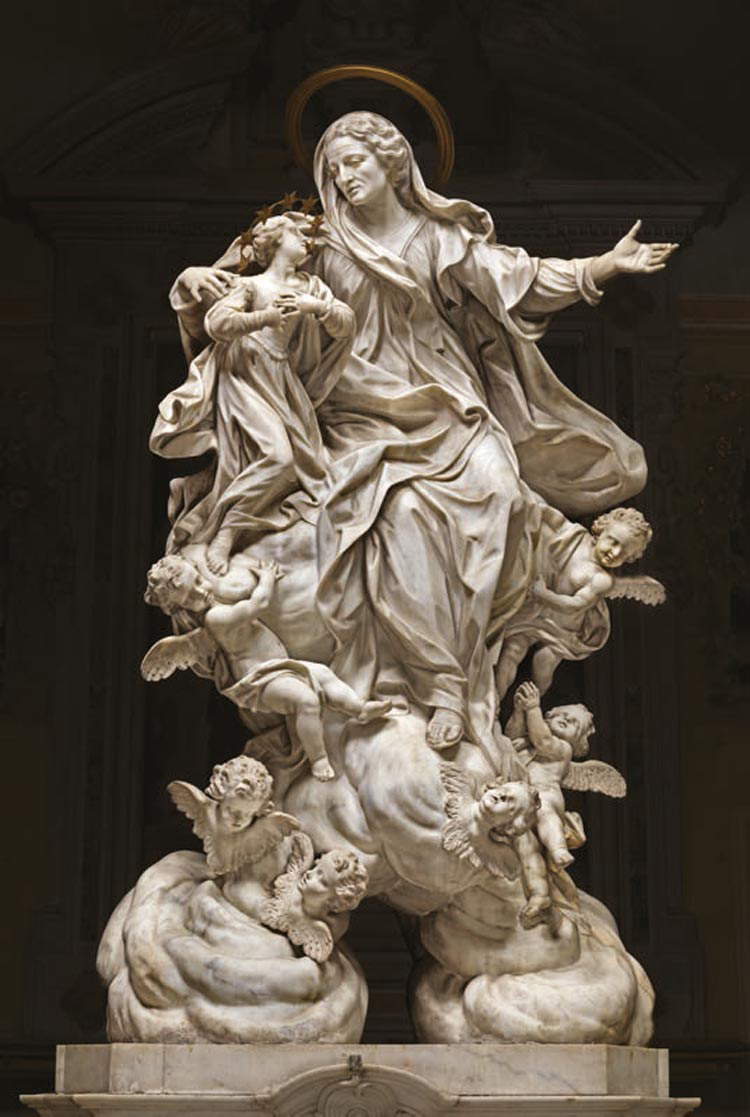
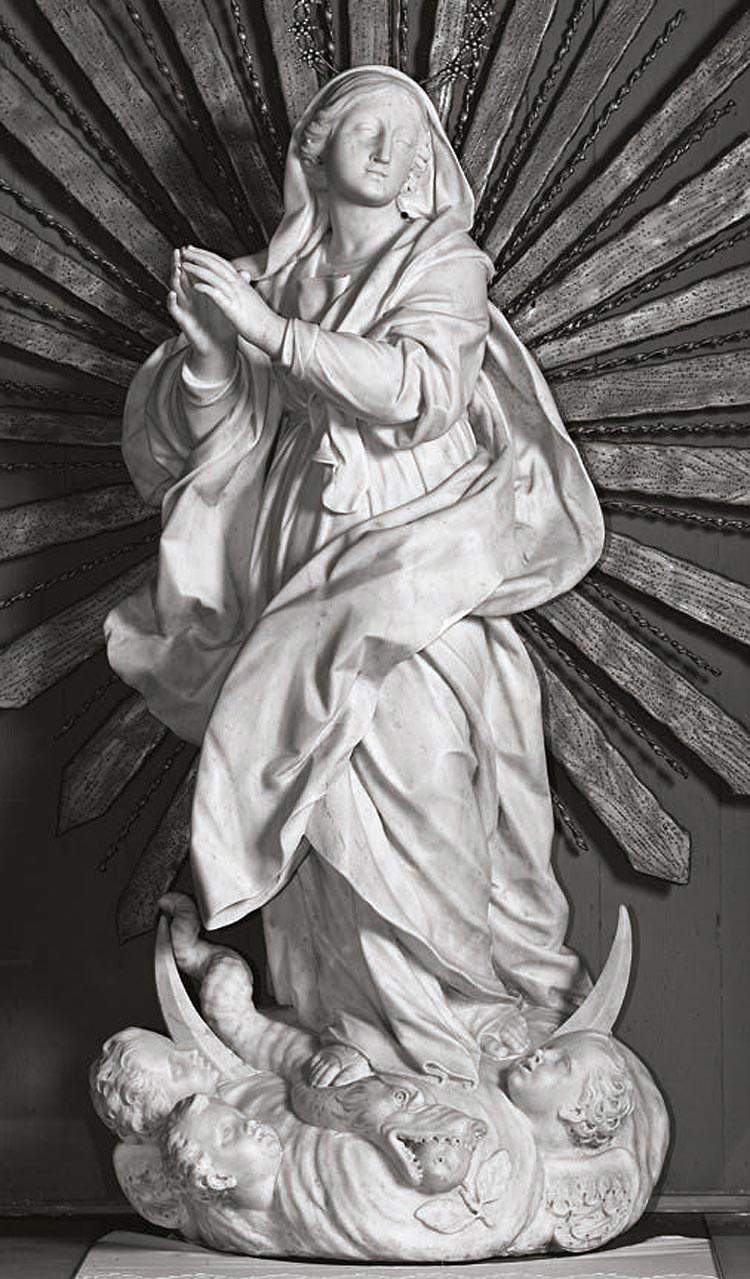
![Giovanni Antonio Cybei, Immaculate Conception (post 1741 [1757]; statuary marble sculpture, 123 x 36 x 30 cm; Carrara, former Civic Hospital, Azienda USL Toscana Nord-Ovest) Giovanni Antonio Cybei, Immaculate Conception (post 1741 [1757]; statuary marble sculpture, 123 x 36 x 30 cm; Carrara, former Civic Hospital, Azienda USL Toscana Nord-Ovest)](https://cdn.finestresullarte.info/rivista/immagini/2021/1765/giovanni-antonio-cybei-immacolata-concezione.jpg
)
The discovery of theImmaculate Conception is accompanied by an extensive catalog with studies by Langosco, Santamaria, and Fausta Franchini Guelfi, who in the volume profiles marble sculpture in Genoa between the seventeenth and eighteenth centuries, all enriched by an extensive iconographic apparatus that finds its apex in thephotographic atlas by Mauro Magliani, a specialist in the photography of sculpture, who has lingered on the most significant details of theImmaculate Conception and some of the works that have been placed in comparison with it.
Genoa thus rediscovers a pinnacle of late Baroque sculpture, and in particular of a late Baroque sculpture that surprises the relative for its scenographic gimmicks, but at the same time poses with grace and refinement: a lofty product of the manner of Francesco Maria Schiaffino, the peerless artist who sculpted the Madonna Queen of Genoa that stands in the center of the Doge’s Chapel in the Doge’s Palace, the talented master who at the time was at theapex of his fortune, and had become the first and most sought-after marble sculptor in Liguria, able to get his works even outside the borders of the Republic, providing suggestions to artists working elsewhere, as seen with Cybei. A find of great importance, splendid news for anyone who loves art, a discovery that is the merit of a team of 30-year-olds. A pinnacle of late Genoese Baroque that is now on public display at Goldfinch’s headquarters, inside what was once the Palace of Lazzaro and Giacomo Spinola, in the heart of Via Garibaldi, the “Strada Nuova” of Genoa’s Rolli. Those who want to see Schiaffino’sImmaculate Conception have until July 1.
Warning: the translation into English of the original Italian article was created using automatic tools. We undertake to review all articles, but we do not guarantee the total absence of inaccuracies in the translation due to the program. You can find the original by clicking on the ITA button. If you find any mistake,please contact us.